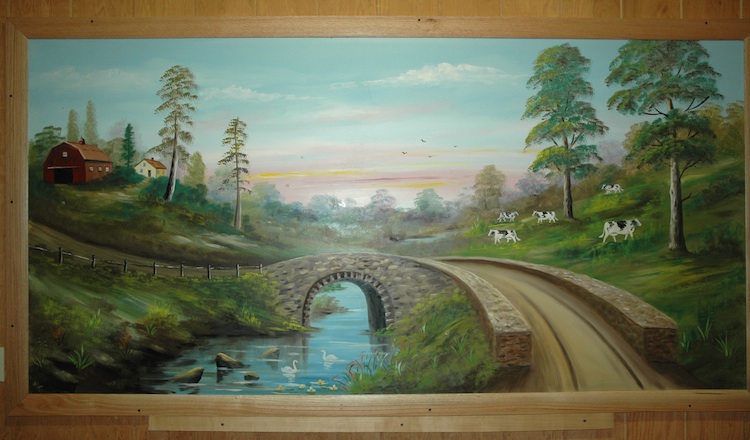In the Fall of 2012, this 1958 painting by F.H. Engebretson was given to the Brodhead Historical Society by the family of Franklyn II “Bud” and Kathryn (Kay) Condon. A phone conversation between Carol Gombar and Pete Condon gave us the following information.
During 1958, an addition was built onto the (Bud and Kay) Condon house at 407 W. 2nd Ave. in Brodhead. This added onto the rear of the house and made an upper “boys’ dorm room” for Pete and his younger brothers. Their parents arranged for Mr. Engebretson, a neighbor who painted signs, barn murals and also pictures in other sizes, to paint two pictures right on walls upstairs. One was in the large “dorm room”, and one* in the room of the eldest son, Franklyn III. It is not known who selected the topics or themes for these paintings, but it is likely that Mr. Engebretson chose the themes, and the parents approved them.

The “Condon Painting” by famed Brodhead mural artist Frank Engebretson currently hangs in the Historical Society Depot Museum.
This painting, from the larger room, was done in mostly exterior enamels and/or house paints (Mr. Engebretson’s usual method) on half-inch drywall wallboard which was on an outer wall of the room. When the painting was finished, carpenters built desks and other items around it and on other walls for the convenience of the boys. Pete remembers: “Dad would go upstairs every day where Mr. Engebretson was painting, and sit and watch, and companionably talk to him. Finally, Engebretson said to him in exasperation, “If you want me to get this painting done Bud, you’ll have to go away so I can think while I work!” Dad did, and everyone was pleased with the painting when it was done.”
In the fall of 2012, when the family decided to give the painting to the Historical Society, it was not definite that it could be removed safely from the wall. Pete Condon supervised the work, cutting around the perimeter, removing nails that went through the drywall construction, and re-gluing small painted pieces that had flexed free. It was laid flat on the floor and a backing of exterior-grade plywood was applied with non-acidic glue, and the framing subsequently applied to the front. It is now very heavy, requiring special handling and hanging methods.
When not displayed for public viewing, this picture will be carefully stored in one of our climate-controlled facilities.
*The second painting, in Franklyn III’s room, was painted directly on a lath-and-plaster wall surface and is not removable for preservation.
